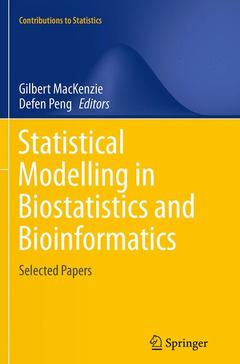Description
Statistical Modelling in Biostatistics and Bioinformatics, Softcover reprint of the original 1st ed. 2014
Selected Papers
Contributions to Statistics Series
Coordinators: MacKenzie Gilbert, Peng Defen
Language: English
Subjects for Statistical Modelling in Biostatistics and Bioinformatics:
Publication date: 08-2016
Support: Print on demand
Publication date: 05-2014
244 p. · 15.5x23.5 cm · Hardback
Description
/li>Contents
/li>Biography
/li>Comment
/li>
Professor Gilbert MacKenzie has a research background in Epidemiology, Biostatistics and Mathematical Statistics. His current research interests include multivariate survival modelling, frailty modelling and covariance modelling. He has published a wide range of research papers and reports and is a past President of the Irish Statistical Association. He holds an adjunct Professorship in Statistics in the University of Limerick and was a visiting Professor in Statistics at ENSAI, France, from 2010 to 2011.
Professor Defen Peng was a visiting Professor in Statistics and senior Research Fellow in the BIO-SI research programme at Limerick from 2009 to 2010. Professor Peng originally worked in the field of Economics at Zhongnan University of Economics and Law, PRC. She has published widely and is currently pursuing several areas of Statistics, such as: survival analysis with frailty, bivariate survival analysis, and the stability of regression models with categoricalcovariates.



